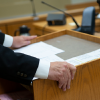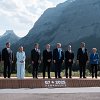Dean Werk was supposed to be gearing up for a busy summer on the Fraser River in British Columbia. Instead, the Métis owner of Great River Fishing Adventures is watching his calendar empty out as American clients, once the lifeblood of his business, cancel trips one after another.
Earlier this year, Werk’s company — known for helping clients catch and release some of the biggest sturgeon on the river — lost a US group worth $85,000.
“We worked for two years to put this package together for them. And that booking got cancelled,” Werk said.
Soon after, a $65,000 booking was also lost.
Werk is concerned this is just the beginning and the sector could face a situation similar to the pandemic, when Indigenous tourism saw international travel collapse and struggled for years to partially recover.
.png)
Across Canada, Indigenous businesses are reporting a significant drop in tourism from the United States. The Indigenous Tourism Association of Canada (ITAC) projected US bookings will fall nearly 70 per cent compared to last year, with advanced bookings for flights between Canada and the US expected to remain down by more than 70 per cent each month through September.
Operators point to tariffs, geopolitical tensions and shifting travel advisories as key factors.
Robert French, who manages Big Land Fishing Lodge in Newfoundland and Labrador, has seen similar declines and described the trend as reciprocal.
“Canadians going to the US have decided to stay at home. And I think this is vice versa. A lot of US people are trying to start to stay home and travel within their own country,” French said.
For many Indigenous operators, the loss of American visitors is devastating. US travelers have historically accounted for the bulk of bookings, with international guests spending more and staying longer than domestic tourists.
Werk said Indigenous tour operators often depend on the US market for as much as 60 to 80 per cent of their clientele.
According to government documents, Indigenous tourism in Canada has still not recovered after the pandemic. The businesses generated $4 billion in 2019, but by 2023, that number had dropped to $3.7 billion — and the real value is even lower when adjusted for inflation. Now, as the industry hoped for a full rebound, operators are facing a new wave of challenges with even fewer safety nets.
Federal support plummets
A central concern for the sector is the steep drop in federal funding. In Budget 2024, Ottawa invested $2.5 million for ITAC (which is not part of the government). That’s less than 10 per cent of the $33 million the organization requested for operations, marketing and development as part of a 2030 strategy to make Canada a world leader in Indigenous tourism.
The funding cuts forced ITAC to lay off about half its staff and halt support for smaller provincial organizations, putting their futures in jeopardy. Keith Henry, CEO and president of ITAC, said the reductions risk setting the industry back a decade and damaging its reputation among major tourism buyers and sellers.
This year, federal support has fallen even further. For 2025-2026, Indigenous Services Canada funding is down to $1.25 million, Innovation, Science, and Economic Development Canada has dropped to zero and Destination Canada’s contribution is now $1.9 million.
The total reduction amounts to $4.55 million, representing about a 68 per cent cut to ITAC in a single year.
Henry said the sector is being told by the federal government that tourism is “poised to do great in 2025,” but that message does not reflect the reality for Indigenous operators on the ground. The operators are also seeing a decline in tourists from other international origins beyond the US as a result of tensions between Canada and the US, and conflicts elsewhere.
Henry said the situation is a serious setback for Indigenous-led tourism across the country.
“We’ve seen a continued decline of federal government support for Indigenous tourism. It feels like Canada has lost any true vision or interest to invest and believe in Indigenous-led tourism, despite public words,” Henry said.
Indigenous Services Canada has yet to respond to Canada’s National Observer’s request for comment and further information.
Domestic marketing
Meanwhile, international arrivals are dropping sharply. In March 2025, trips to Canada by US residents fell 6.6 per cent year over year, while arrivals from overseas residents plunged 17.4 per cent. The numbers are continuing to decline as trade tensions persist.
In response to the decline in international tourists, ITAC has ramped up domestic marketing efforts, launching the “Original Original” campaign to encourage Canadians to explore Indigenous tourism in their own backyard.
The association has increased its presence through advertising, television commercials and bus wraps in major cities, such as Edmonton, Toronto, Winnipeg, Halifax and Vancouver as well as the North.
Henry said the efforts are crucial for raising awareness among Canadian travellers, but domestic tourism cannot make up for the loss of international visitors, especially Americans.
“Domestic travellers spend less and don’t stay as long. International customers spend six to eight hundred dollars per person, versus a Canadian who spends maybe one to two hundred. The math doesn’t make sense if we lose those international guests,” Henry said.
Additional pressures mount
While operators struggle with lost bookings and shrinking federal support, many are now contending with a new set of pressures making recovery even harder. In Churchill, Manitoba, David Daley is facing a “triple hit.”
Daley, a Métis long-distance dogsled racer who runs Wapusk Adventures, said wildfires have forced evacuations across Manitoba and Saskatchewan, creating confusion for tourists and immediate ripple effects for local businesses, as the province urges people to avoid “unnecessary travel” to the region.
“We’re open for business, but then the province is saying we’re closed for business. It’s a mixed message that the tourists are getting,” Daley said.
“That’s not very good news for the tourism industry.”
He said there is no emergency fund to support operators through disasters like wildfires, leaving many exposed to sudden losses. On top of this, costs are spiraling. Daley said since the pandemic, insurance premiums for his hotel have soared, adding yet another burden to an already fragile sector.
He has also diversified his offerings beyond dog sledding to e-bike rentals, a storefront, a hotel and Aurora viewing, but can't fully offset the uncertainty and financial strain facing the business.
“How many rooms do you have to rent to just pay your insurance? Never mind your loans to own up a piece of property like that?” he said.
Indigenous tourism business operators have also reported rising costs for fuel, food, and equipment.
Werk said uncertainty is weighing heavily on everyone in the industry and the federal government needs to recognize the scale of the crisis and act decisively.
“It’s not just one year. It’s cumulative over potentially the next three or four years until we get this all straightened out,” he said. “If things don’t change, I’m not sure how much longer we can keep going.”
Sonal Gupta / Local Journalism Initiative / Canada’s National Observer








.png)








